Siloxane Precursor-Based Protective Coatings for High Modulus Carbon Fibers in Ceramic Matrix Composites
Abstract
:1. Introduction
2. Materials and Methods
2.1. Fiber Coating
2.2. Composite Preparation
2.3. Thermogravimetric Analysis
2.4. Thermal Aging Treatment
2.5. Flexural Strength
3. Results
3.1. Optical Characterization of Fiber Coatings
3.2. Thermogravimetric Analysis
3.3. Determination of Fiber Volume Content
3.4. Flexural Strength
- Untreated HM carbon fiber-reinforced SiOC (reference)
- 3 wt. % SILRES® MK-coated HM carbon fiber-reinforced SiOC
3.5. Fractographic Study
4. Discussion
5. Conclusions
Author Contributions
Funding
Conflicts of Interest
References
- Evans, A.G. Perspective on the Development of High-Toughness Ceramics. J. Am. Ceram. Soc. 1990, 73, 187–206. [Google Scholar] [CrossRef]
- Sauder, C. Ceramic Matrix Composites: Nuclear Applications. In Ceramic Matrix Composites: Materials, Modeling and Technology; Bansal, N.P., Lamon, J., Eds.; Wiley: Hoboken, NJ, USA, 2015; pp. 609–646. [Google Scholar]
- Mouritz, A.P. Introduction to Aerospace Materials; Elsevier: New York City, NY, USA, 2012. [Google Scholar]
- Chawla, K.K. Composite Materials: Science and Engineering; Springer Science & Business Media: Berlin, Germany, 2012. [Google Scholar]
- Singh, J.P.; Singh, D.; Sutaria, M. Ceramic composites: Roles of fiber and interface. Compos. Part A Appl. Sci. Manuf. 1999, 30, 445–450. [Google Scholar] [CrossRef]
- Tong, D.; Wang, H.; Wang, L.; Chen, L.; Li, Z. Coating of poly(carborane-carbosilane-phenylacetylene) on carbon fibers with excellent oxidation protection. Surf. Coat. Technol. 2017, 319, 335–344. [Google Scholar] [CrossRef]
- Latzel, S.; Vaßen, R.; Stöver, D. New Environmental Barrier Coating System on Carbon-Fiber Reinforced Silicon Carbide Composites. J. Therm. Spray Technol. 2005, 14, 268–272. [Google Scholar] [CrossRef]
- Westwood, M.E.; Webster, J.D.; Day, R.J.; Hayes, F.H.; Taylor, R. Oxidation protection for carbon fibre composites. J. Mater. Sci. 1996, 31, 1389–1397. [Google Scholar] [CrossRef]
- Koch, D.; Tushtev, K.; Grathwohl, G. Ceramic fiber composites: Experimental analysis and modeling of mechanical properties. Compos. Sci. Technol. 2008, 68, 1165–1172. [Google Scholar] [CrossRef]
- Thouiess, M.D.; Sbaizero, O.; Sigl, L.S.; Evans, A.G. Effect of Interface Mechanical Properties on Pullout in a SiC-Fiber-Reinforced Lithium Aluminum Silicate Glass-Ceramic. J. Am. Ceram. Soc. 1989, 72, 525–532. [Google Scholar] [CrossRef]
- Aggour, L.; Fitzer, E.; Heym, M.; Ignatowitz, E. Thin coatings on carbon fibers as diffusion barriers and wetting agents in Al composites. Thin Solid Films 1977, 40, 97–105. [Google Scholar] [CrossRef]
- Schmidt, S. Beschichtung von Kohlenstofffasern Durch Chemische Gasphasenabscheidung (CVD). Ph.D. Thesis, Technische Fakultaet—Universitaet Erlangen-Nuerenberg, Erlangen, Germany, 2004. [Google Scholar]
- Kern, F.; Gadow, R. Liquid phase coating process for protective ceramic layers on carbon fibers. Surf. Coat. Technol. 2002, 151–152, 418–423. [Google Scholar] [CrossRef]
- Gadow, R.; Kern, F. Continuous Liquid Phase Coating of Carbon Fibers with Kion VL 20® Polysilazane. Adv. Eng. Mater. 2003, 5, 799–801. [Google Scholar] [CrossRef]
- Riedel, R.; Gadow, R.; Klingebiel, U. Synthesis and High Temperature Stability of Amorphous Ceramics in the System Si-B-C-N Derived from Polymer Precursors and Their Application for Liquid Phase Coatingof Carbon Fibers: Sub-Project IFKB—Universität Stuttgart (Project Nr.: GA589/2-4); Project Report in the Framework of the DFG Priority Program; Unpublished work; 2018. [Google Scholar]
- Colombo, P.; Mera, G.; Riedel, R.; Sorarù, G.D. Polymer-Derived Ceramics: 40 Years of Research and Innovation in Advanced Ceramics. J. Am. Ceram. Soc. 2010, 73, 1805–1837. [Google Scholar] [CrossRef]
- Kern, F.; Gadow, R. Deposition of ceramic layers on carbon fibers by continuous liquid phase coating. Surf. Coat. Technol. 2004, 180–181, 533–537. [Google Scholar] [CrossRef]
- Deutsches Institut für Normung. Advanced Technical Ceramics—Mechanical Properties of Ceramic Composites at Room Temperature. Part 3: Determination of Flexural Strength; EN 658-3:2002; Deutsches Institut für Normung: Berlin, Germany, 2002. [Google Scholar]

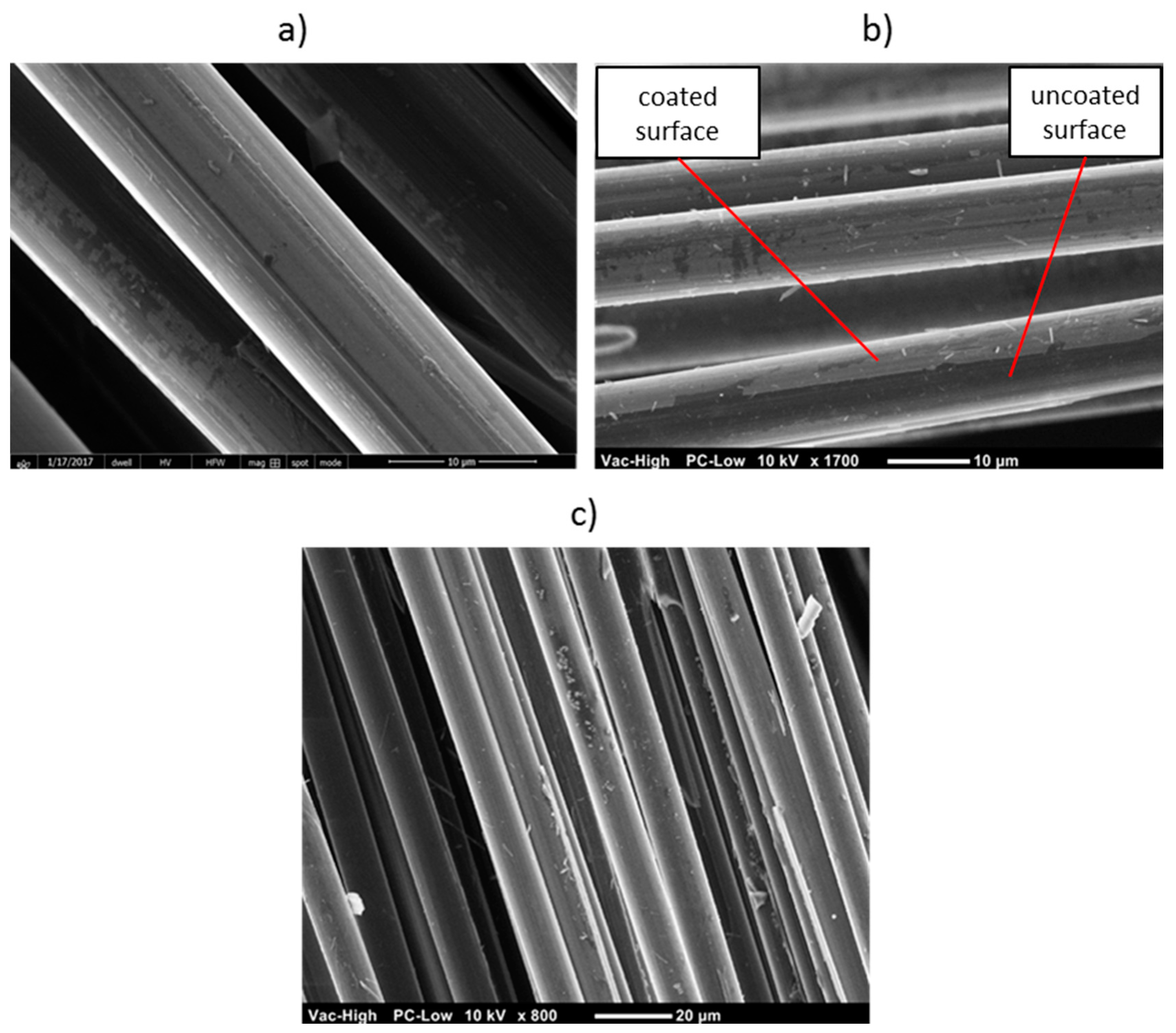
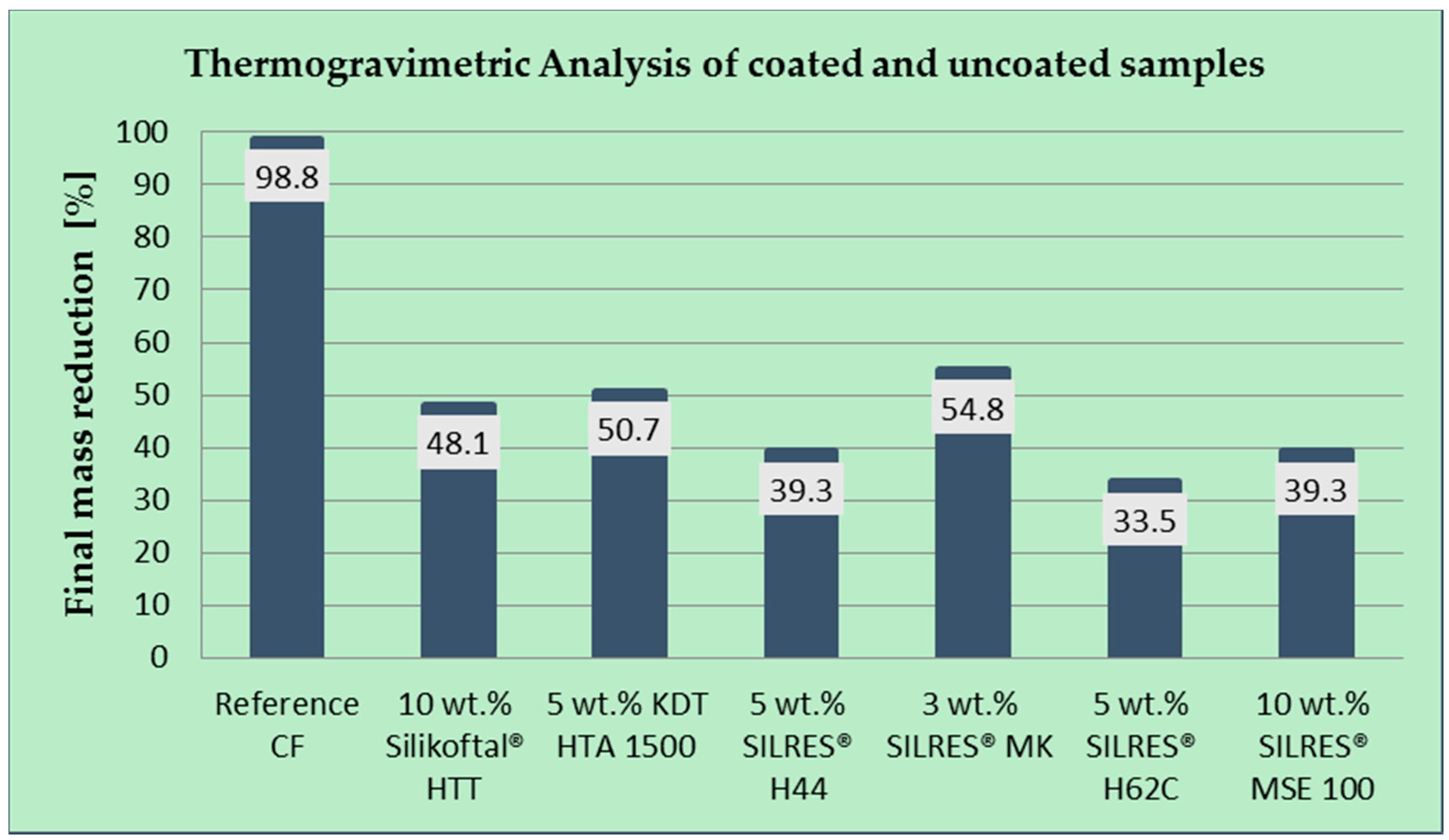
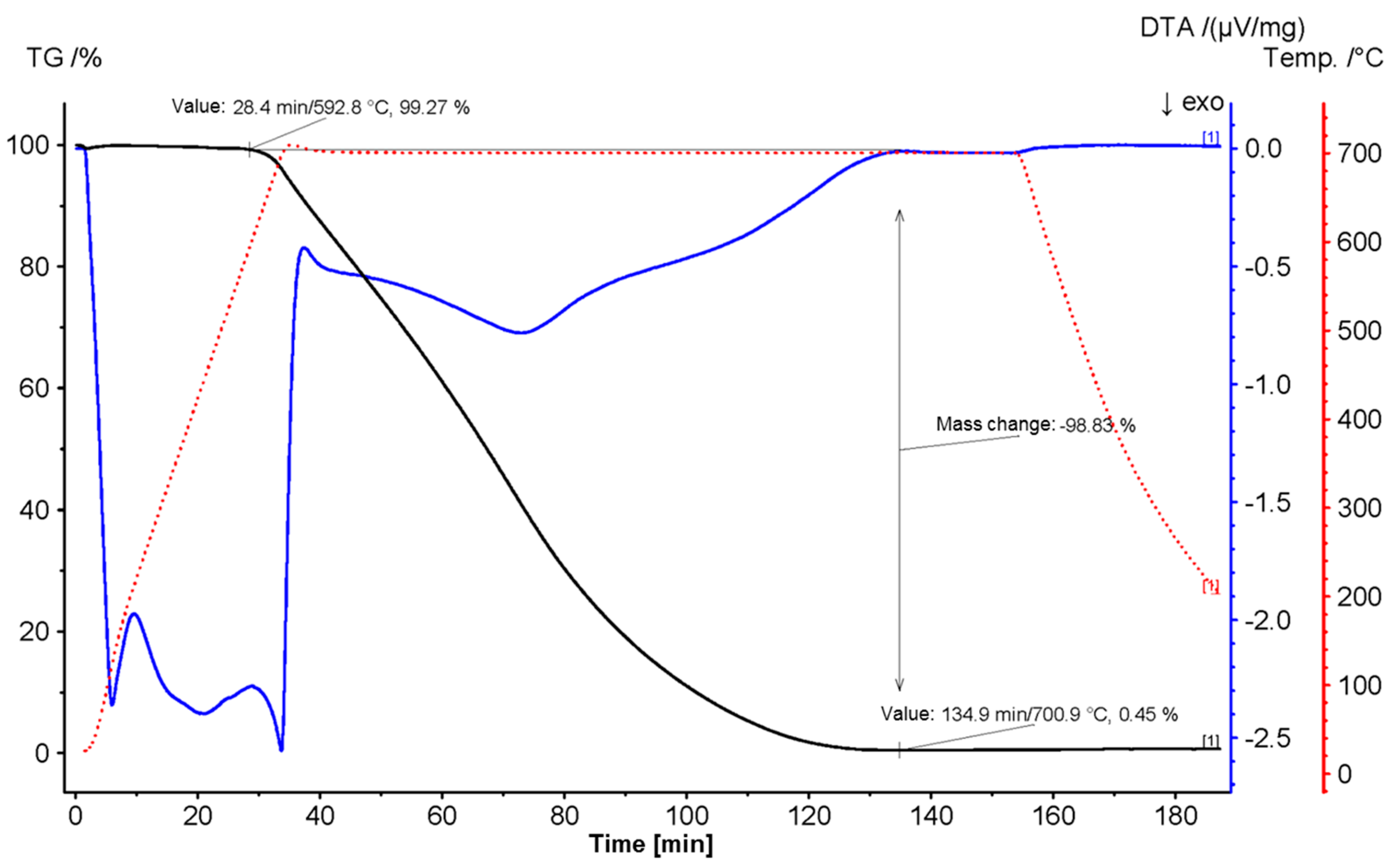
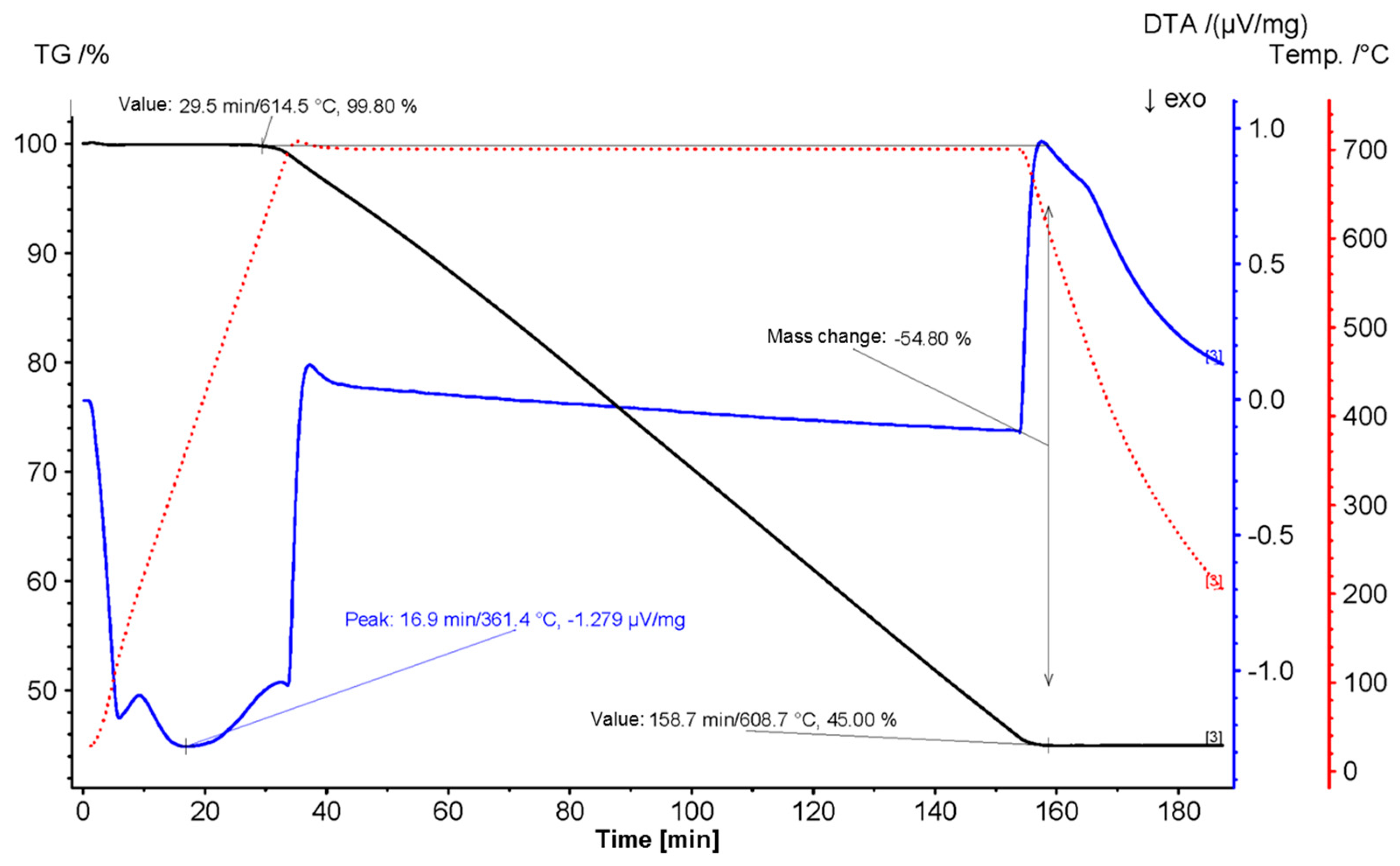
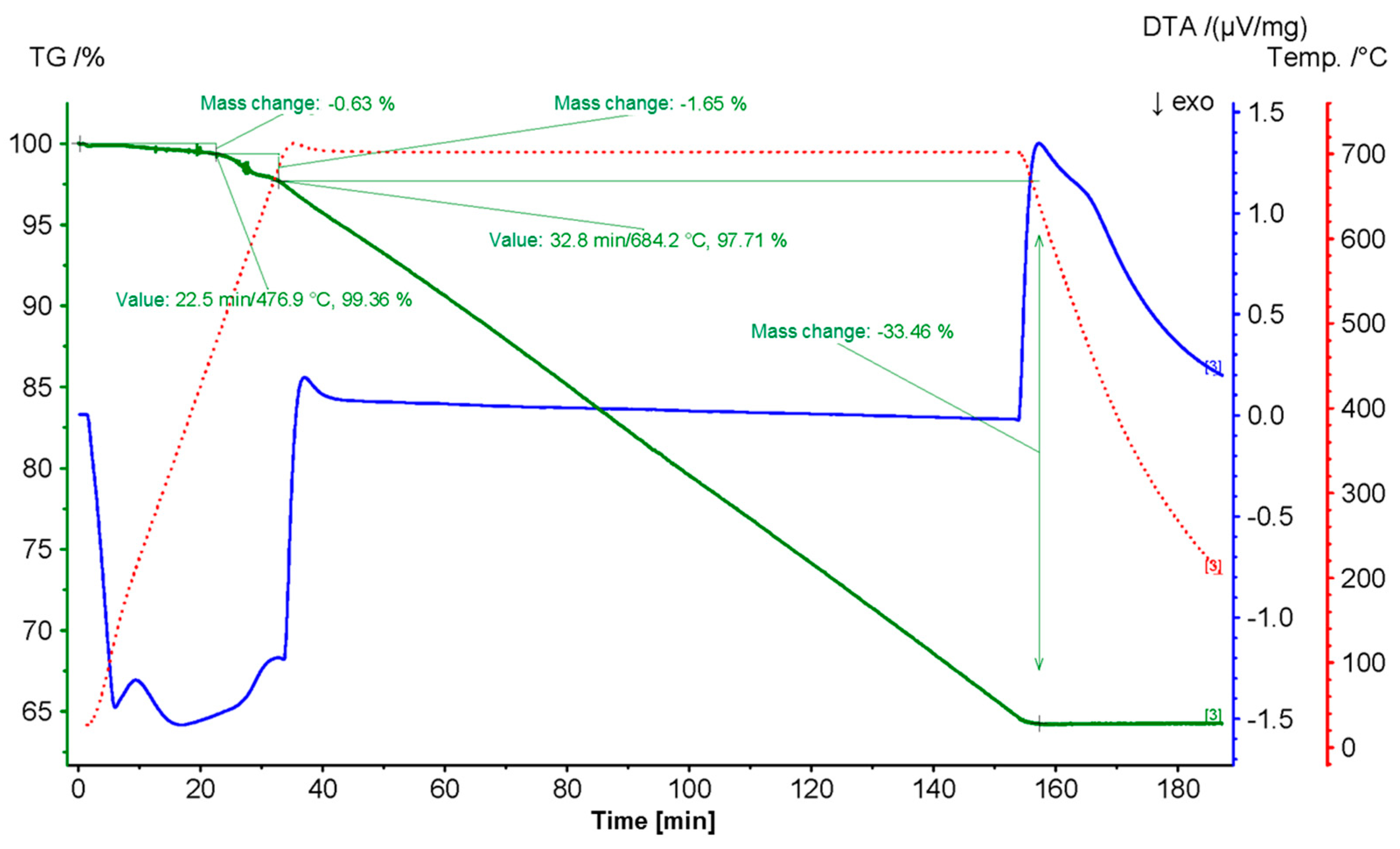
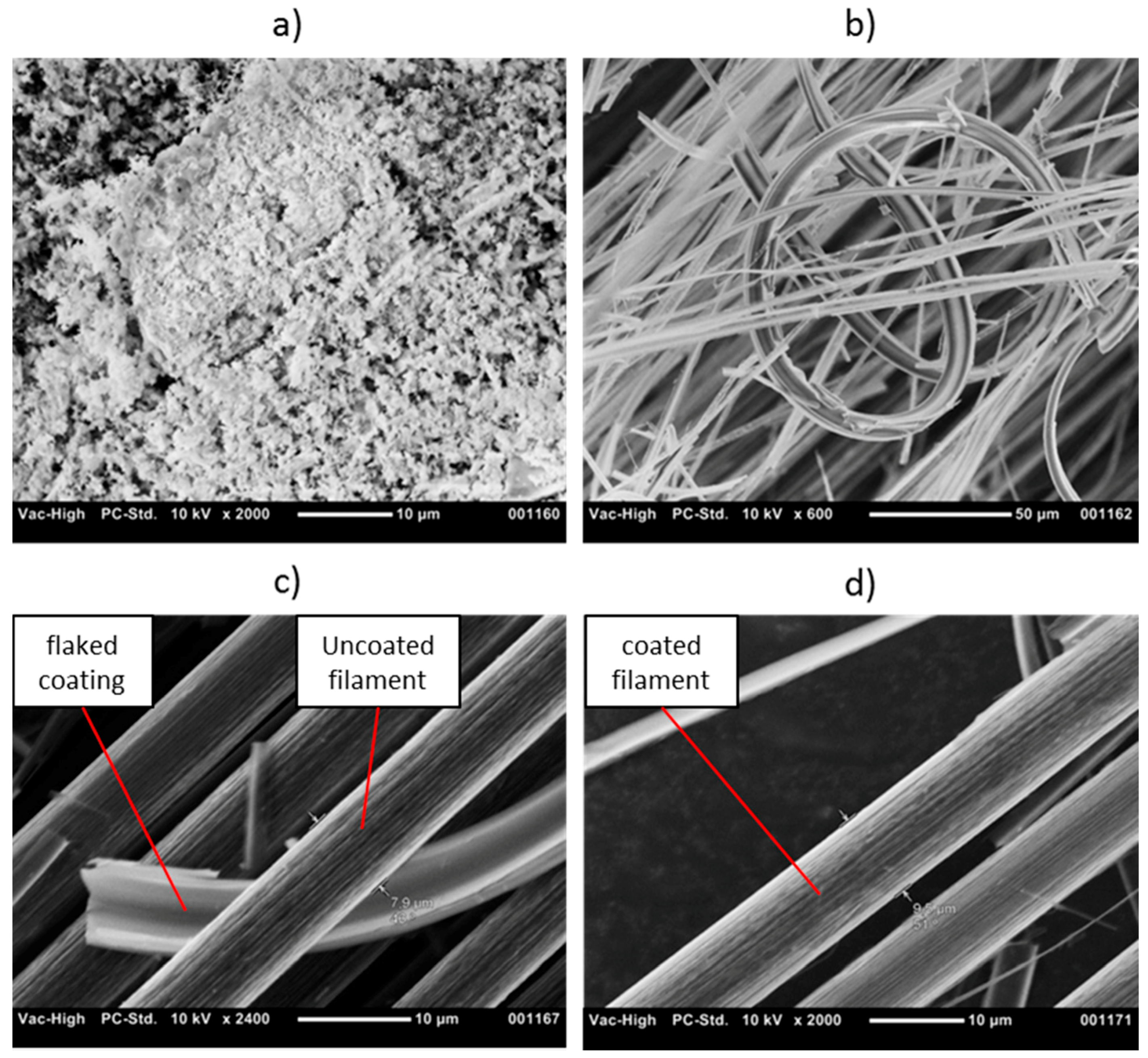
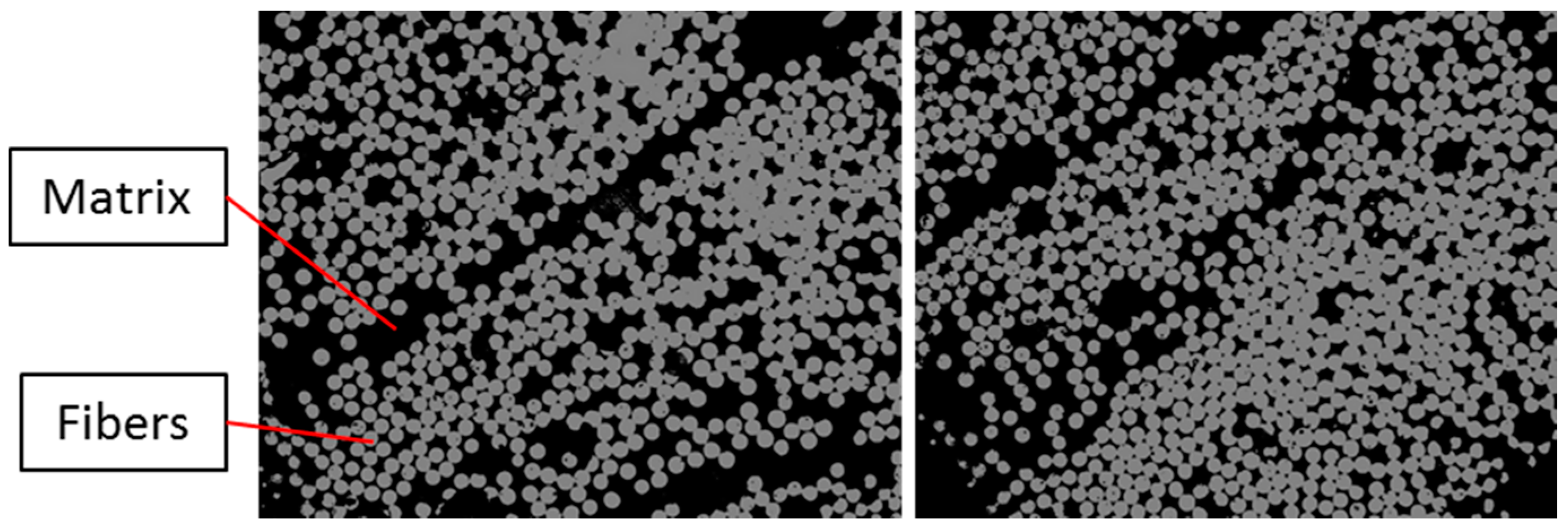
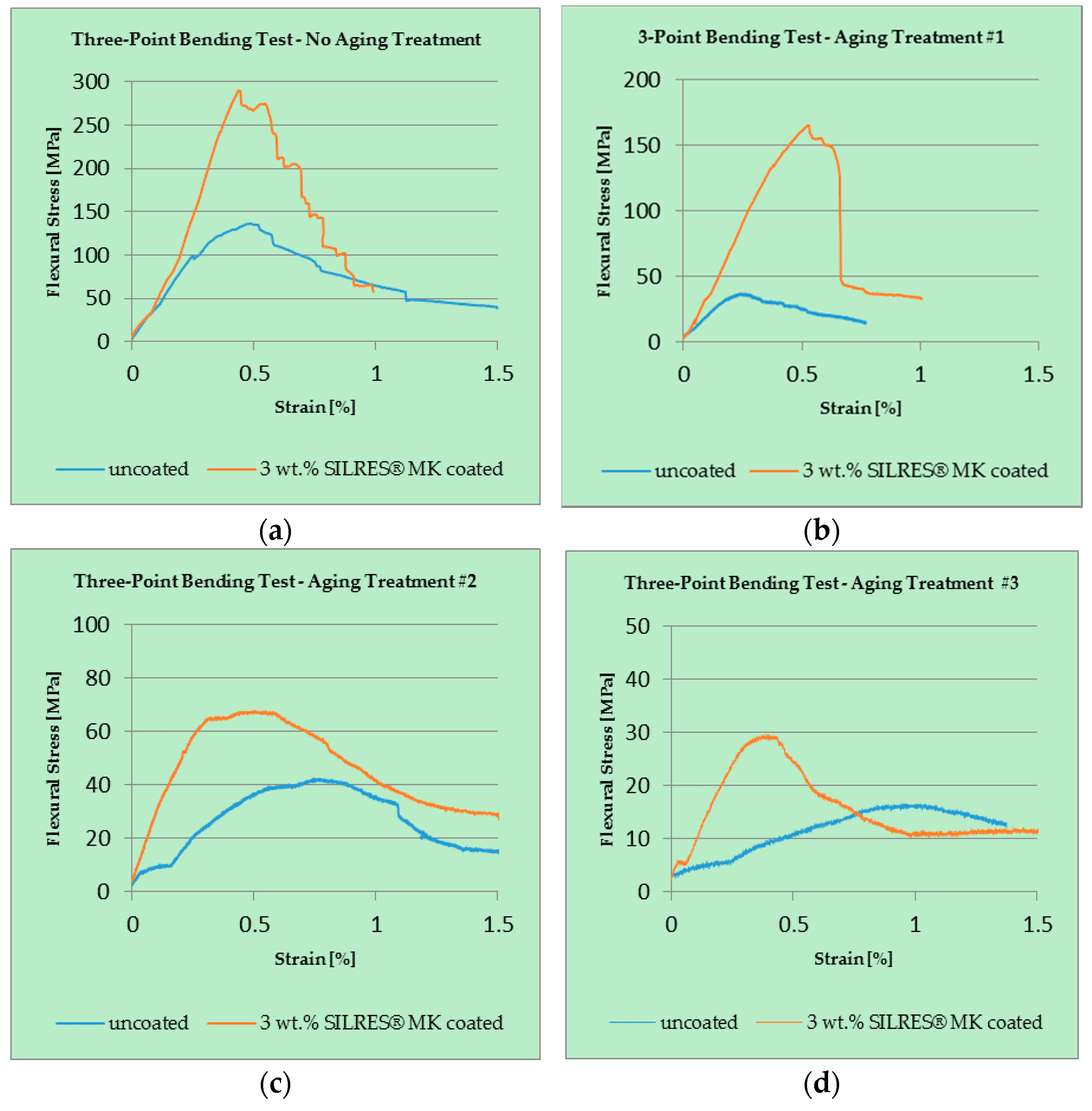
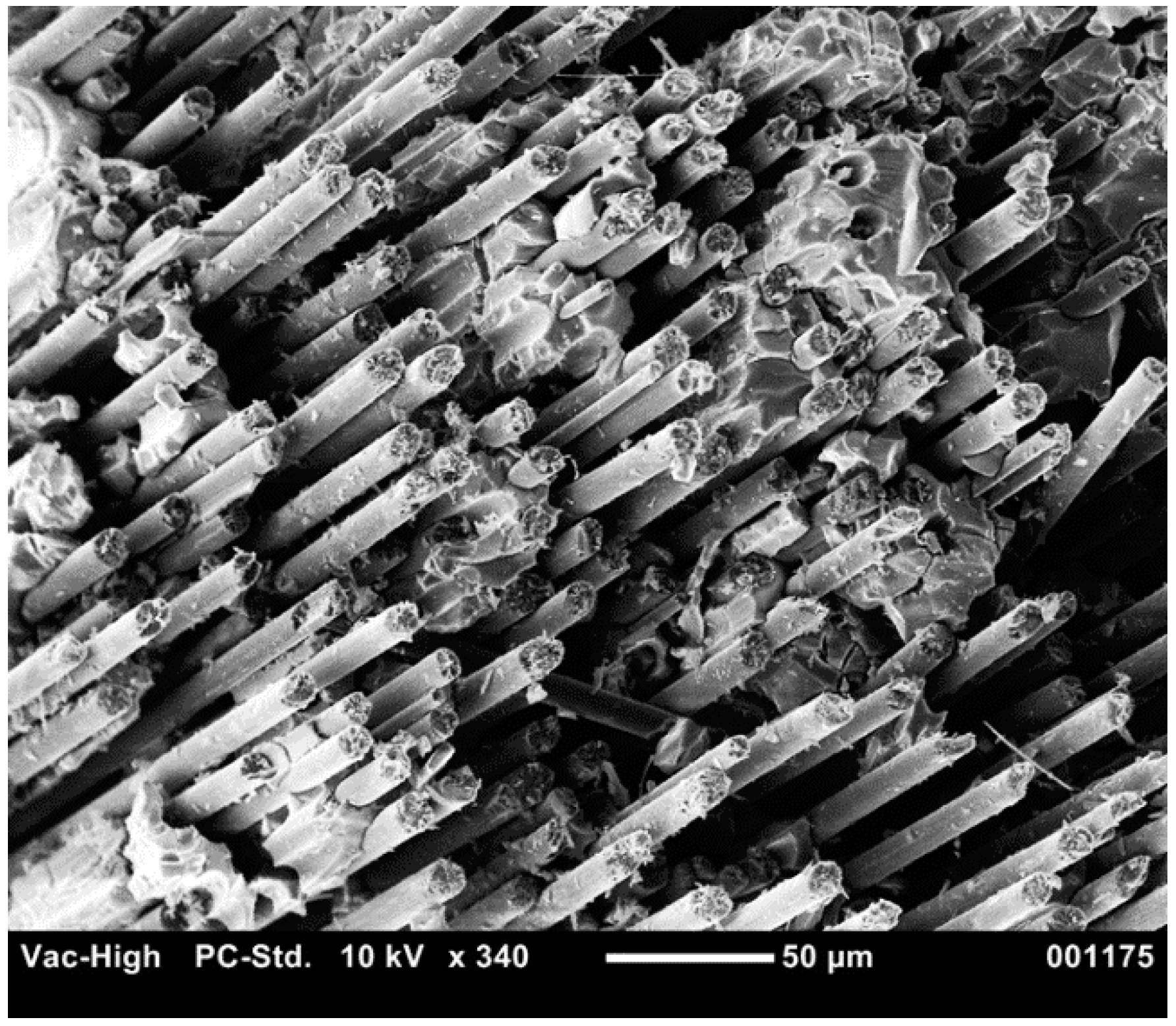
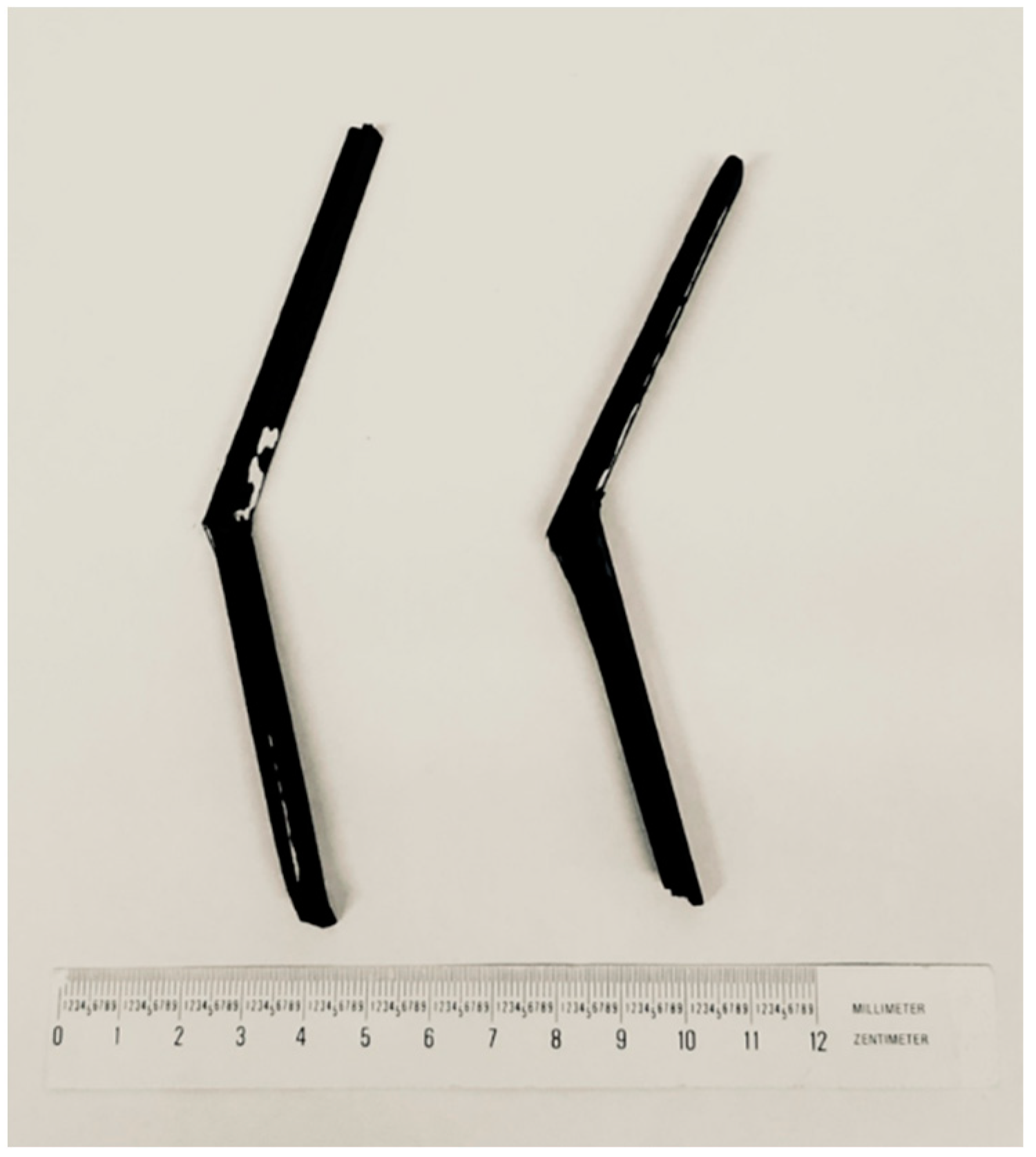
| Precursor | Precursor Type | Concentration | Solvent |
|---|---|---|---|
| Silikoftal® HTT (Evonik, Essen, Germany) | Silicon Polyester Resin | 10% | MEK |
| KDT HTA 1500 (KiON Defense, Huntingdon Valley, PA, USA) | Polysiloxazane | 5% | MEK |
| SILRES® H 44 (Wacker, München, Germany) | Phenylmethyl Polysiloxane Resin | 5% | MEK |
| SILRES® H62 C (Wacker) | Polysiloxane | 5% | MEK |
| SILRES® MSE 100 (Wacker) | Methyl Polysiloxane | 10% | MEK |
| SILRES® MK (Wacker) | Methyl Silicon Resin | 3% | Isopropanol |
| Aging Treatment | Temperature (°C) | Duration (min) |
|---|---|---|
| #1 | 600 | 60 |
| #2 | 650 | 30 |
| #3 | 600 | 120 |
© 2018 by the authors. Licensee MDPI, Basel, Switzerland. This article is an open access article distributed under the terms and conditions of the Creative Commons Attribution (CC BY) license (http://creativecommons.org/licenses/by/4.0/).
Share and Cite
Jiménez, M.; Samie, A.; Gadow, R.; Kern, F.; Bill, J. Siloxane Precursor-Based Protective Coatings for High Modulus Carbon Fibers in Ceramic Matrix Composites. Ceramics 2018, 1, 128-138. https://doi.org/10.3390/ceramics1010011
Jiménez M, Samie A, Gadow R, Kern F, Bill J. Siloxane Precursor-Based Protective Coatings for High Modulus Carbon Fibers in Ceramic Matrix Composites. Ceramics. 2018; 1(1):128-138. https://doi.org/10.3390/ceramics1010011
Chicago/Turabian StyleJiménez, Miguel, Armaghan Samie, Rainer Gadow, Frank Kern, and Joachim Bill. 2018. "Siloxane Precursor-Based Protective Coatings for High Modulus Carbon Fibers in Ceramic Matrix Composites" Ceramics 1, no. 1: 128-138. https://doi.org/10.3390/ceramics1010011





